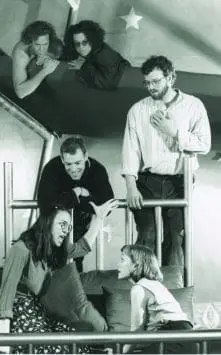Reawakening “A Midsummer Night’s Dream”
Reawakening “A Midsummer Night’s Dream”
by Paige Farestveit
In 1998, the Arden Theatre Company’s brand new F. Otto Haas Stage opened with a remarkable production of A Midsummer Night’s Dream, directed by company co-founder Aaron Posner, that featured a cast that can only be described as an embarrassment of riches: TonyBraithwaite, Pearce Bunting, Jen Childs, Melanye Finister, Grace Gonglewski, Scott Greer, Leonard Haas, and Ian Merrill Peakes, among others. That year, the Arden led the pack in Barrymore nominations, garnering twenty four total, eight of which were for Midsummer, including Overall Production of a Play, Ensemble Performance, Direction of a Play, Set Design, and more.

Pearce Bunting, Robert Christophe, Ian Merrill Peakes, Scott Greer, Grace Gonglewski, Jen Childs. Arden’s 1998 production of A Midsummer Night’s Dream.
Over the last two decades, these artists have not only established themselves as some of the most beloved in the Philadelphia theatre community, but garnered a national reputation for excellence. Some are still regular players on the Arden stage, such as Grace Gonglewski and Ian Merrill Peakes, who have appeared in twenty four and twenty productions, respectively. Others have gone on to Broadway and television work, like Pearce Bunting, who portrayed Bill Austin in Phyllida Lloyd’s rollicking production of Mamma Mia! and appeared on the acclaimed television series Boardwalk Empire. The creative team has likewise fixed themselves in prominent roles on the national stage. Posner has racked up over 250 directing credits at regional theatre companies around the US, and penned celebrated works such as Stupid F**king Bird and District Merchants, while scenic designer David P. Gordon has designed for over 300 productions on and off Broadway.
Posner’s Midsummer was poised at a unique tipping point in the Arden’s history. As the first production staged in the new theatre space, it was not only responsible for drawing on the history and practices that informed the Arden’s developing artistic principles in its first decade of life, but for displaying the rich resources the new space provided and setting a precedent for the young theatre company’s cultural future—to proclaim what the Arden was, and what it was capable of becoming.
According to Producing Artistic Director and co-company founder Terry Nolen, a Shakespearean comedy was the ideal choice for accomplishing such a lofty task. Nolen writes, “Shakespeare was a touchstone for us in 1998. Aaron had a great passion for Shakespeare and we included his work every few years. One of our earliest productions – in 1989 – was As You Like It, from whence the name Arden comes. It was an incredibly beautiful production, and helped establish the Arden’s early reputation as a theatre striving to create exciting and innovative work. We thought opening the F. Otto Haas Stage with another Shakespeare comedy that took us into the woods might be an exciting new way to open our new theatre.”

Pearce Bunting and Melanye Finister. Arden’s 1998 production of A Midsummer Night’s Dream.
Further, “the Haas Stage had height that our previous spaces did not have. You can have sky and second floors and action that takes place above the audiences’ heads. In the design process for that production, Aaron and Set Designer David Gordon knew they wanted to take advantage of that height – and created a set with floating beds and ladders. The set also acknowledged the architecture of the new Haas Stage – lighting the ceiling of the theatre (the structure holding up the roof) and the brick walls (newly painted a deep blue). There is a dream quality to the shade of blue chosen by our architects Kieran & Timberlake, and the design team incorporated that into the visual world of the play, lighting the walls and the ceiling above.”
And finally, Nolen notes that such a production in such a space reinforced the most magical element of live theatre: an awareness that the actors and the audience are in the same room together, sharing an experience both precious and fleeting. Amongst the lushly be-decked Midsummer set, Nolen felt an enduring celebration that “everyone was breathing the same air.”
Shakespeare works were written to be performed in the shared light of the public playhouses in early modern England, where groundlings could cheer, boo, hiss, and heckle in full sight of the actors. Reactions were visceral, honest, and immediate- and it no doubt informed the players’ performances and playgoers’ experiences. By leaning into that history with design and direction, Posner’s Midsummer reached back and pulled a particular bit of Shakespearean magic into the present.
Posner and Nolen’s commitment to shared experiences and fresh Philadelphia talent found new life in this season’s production of A Midsummer Night’s Dream, directed by Matt Pfieffer.

Katharine Powell as Titania, in Arden Theatre Company’s production of A Midsummer Night’s Dream. Photo by Mark Garvin.
Like Posner, Pfeiffer’s production achieves the seemingly impossible task of honoring historical precedent (both Shakespeare’s and the Arden’s) while fiercely pursuing newness. It is an unfortunate truth that contemporary takes on Shakespeare often get so caught up in demonstrating ingenuity that they lose their grip on the text. New stagings become marred by cheap tricks that display an innate mistrust of the audience’s ability to understand four hundred year old verse.
Matt Pfeiffer admirably avoids this trap by stripping away excessive production elements in favor of clear, text-driven storytelling. In his Director’s Notes, Pfeiffer acknowledges the inevitable weight of doing “Shakespeare”—the cultural assumptions and expectations of who Shakespeare is and what his plays should be that follow audiences, for better or for worse, into the playing space.
“History plays an important part in the way you receive Shakespeare,” Pfeiffer writes. “His plays are foundational texts in Western culture. I’m deeply interested in being in conversation with the history of these plays and how Shakespeare’s company would’ve worked on them. How do we as 21st century theatre artists approach this work in the spirit of what Shakespeare had available to him?”

Sean Close as Flute, Brandon J. Pierce as Starvling, Doug Hara as Quince, Taysha Marie Canales as Snout, and Rachel Camp as Snug in Arden Theatre Company’s production of A Midsummer Night’s Dream. Photo by Mark Garvin.
Scenic Designer Paige Hathaway’s peeled back set lets the audience in on the plan from the moment they enter the theatre. Her design is a meeting of the historical and the contemporary theatre. Worn wooden floorboards and a tiring house harken back to the open air playhouses of Shakespeare’s day, while the familiar backstage paraphernalia of a contemporary house—ladders, vanities with bright round lightbulbs, costume pieces and wigs askew—pulls us firmly into the theatrical present. Pfeiffer does not want his audience to lose themselves or their awareness of the theatricality of the experience in an ultra-realistic set. He insists, rather, that we all remain aware and willing participants in the re-telling of a much beloved story.
But to be clear- Pfeiffer is not overly precious with the text, nor with original practice. He describes himself as “committed to working in spirited conversation” with Shakespeare’s world. He pulls in historical elements that assist in the developing of characters and relationships, but always with a contemporary twist. For instance, he draws on the era-appropriate tradition of live music played and sung by members of the company, but the musical selections are hardly early modern. Instead, Alex Bechtel’s beguiling score incorporates folk-rock classics like The Kinks and David Bowie, and infuses original compositions. Pfeiffer also cuts and rearranges Shakespeare’s text to clarify the plot and complicate character arcs; for example, he redistributes some of Theseus’s dialogue to the traditionally silent Hippolyta, and splices together Puck fixing the ass’s nole on Bottom’s head with the sprite’s recounting of the events to Oberon.

Katharine Powell as Titania, and Dan Hodge as Bottom in Arden Theatre Company’s production of A Midsummer Night’s Dream. Photo by Mark Garvin.
It is the ensemble, however, that truly brings this production to life. A dazzling display of established Philadelphia talent and bright up-and-comers, their affection for their story and their company shines brightly. They are effortlessly cool, disarmingly honest, and can rattle off verse with smart specificity. They forgo the fourth wall, and draw the audience close with a genuine invitation of camaraderie.
While watching Pfieffer’s work, it is impossible to ignore the peculiar magic of live performance- that moment of connection between audience and actor, between past and present, which promises that well-loved stories can grow more precious through continued re-telling. We will undoubtedly all look back on this production of A Midsummer Night’s Dream as another defining moment in the Arden’s artistic history—a celebration of where they have been, and a glimpse at the work to come.
 Paige Farestveit earned a M.A. with distinction in Shakespeare Studies from King’s College London and Shakespeare’s Globe in 2016. She is currently hard at work as an Arden Professional Apprentice, and as an understudy for Titania/Hippolyta in A MIDSUMMER NIGHT’S DREAM.
Paige Farestveit earned a M.A. with distinction in Shakespeare Studies from King’s College London and Shakespeare’s Globe in 2016. She is currently hard at work as an Arden Professional Apprentice, and as an understudy for Titania/Hippolyta in A MIDSUMMER NIGHT’S DREAM.
A MIDSUMMER NIGHT’S DREAM by William Shakespeare with Original Music by Alex Bechtel is extended thru April 13. For tickets and info visit www.ardentheatre.org, or call the Box Office at 215.922.1122.

Sean Close as Lysander, Rachel Camp as Helena, and Brandon J. Pierce as Demetrius in Arden Theatre Company’s production of A Midsummer Night’s Dream. Photo by Ashley LaBonde.
